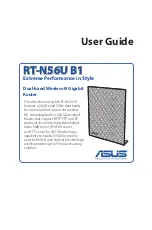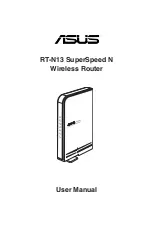
___________________________________________________________________________________
___________________________________________________________________________________
84 RG-5400 Subscriber router
G.729 is also a voice data compression codec with the rate of 8kbps. As with G.723.1, G.729 codec
supports voice activity detector and performs comfort noise generation.
–
Codec 1..6
—you may select a codec and the .and an order of their usage. The highest priority
codec should be specified in the 'Codec 1' field. For operation, you should specify at least one
codec:
Disabled
—codec will not be used;
G.711a—use G.711A codec;
G.711u—use G.711U codec;
G.723—use G.723.1 codec;
G.729—use G.729 codec.
G.726-24 – use G.726-24 codec;
G.726-32 – use G.726-32 codec;
G.711a (wide band) – use G.711a (wide band) codec;
G.711u (wide band) – use G.711u (wide band) codec.
–
Packetization time
– amount of milliseconds (ms) transmitted in a single RTP packet.
–
Dispersion time, ms
– parameter that cancels an echo caused by the voice signal dispersion.
Parameter values may be specified in the interval from 2ms to 128ms.
You may specify alternative voice codecs for the selected direction.
For each direction, you may
specify the preferred codec for voice communication in the numbering schedule. Configuration is
performed in the numbering schedule. For each direction, an additional codec configuration may
be specified in parentheses after the 'codecs:' word. If you have to use multiple codecs, you may
separate them with a comma ','. Multiple parameters may be specified for a single direction. In
this case, separate them with a semicolon ';' - (param1:subparam1,subparam2;
param2:subparam1,subparam2). SubparamX permitted values: g711a, g711u, g729, g723.
param1 and param2 permitted values — ‘codecs’ and ‘rfc2833_PT’ respectivly.
Example: ([23]xxx(codecs:g729;
rfc2833_PT:96
)|8x.(codecs:g711a;g711u)).
Jitter buffer
Jitter is a deviation of time periods dedicated to packet delivery. Packet delivery delay and jitter are
measured in milliseconds. Jitter value is higher for real time data transfers (e.g. voice or video data).
In RTP, also known as 'media stream protocol', there is a field for precision transmission time tag related
to the whole RTP stream. Receiving device uses these time tags to learn when to expect the packet and
whether the packet order has been observed. On the basis of this information, the receiving side will learn how
to configure its settings in order to evade potential network problems such as delays and jitter. If the expected
time for packet delivery from the source to the destination for the whole call period corresponds to the defined
value, e.g. 50ms, it is fair to say that there is no jitter in such a network. But packets are delayed in the network
frequently, and the delivery time period may fluctuate significantly (in the context of time-critical traffic). If the
audio or video recipient application will play packets in the order of their reception time, voice (or video)
quality will deteriorate significantly. For example, if the voice data is being transferred, there will be
interruptions and interference in the voice.
The device features the following jitter buffer settings:
–
Minimum delay, ms –
minimum expected IP package network propagation delay;
–
Maximum delay, ms –
maximum expected IP package network propagation delay;
–
Threshold for immediate packet deletion, ms
– maximum amount of time for voice package
removal from the buffer. The parameter value should be greater or equal to maximum delay;















































